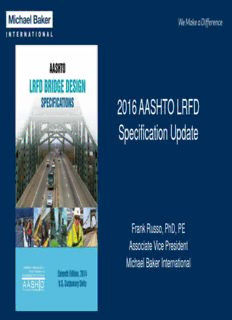
2016 AASHTO LRFD Specification Update PDF
Preview 2016 AASHTO LRFD Specification Update
2016 AASHTO LRFD Specification Update Frank Russo, PhD, PE Associate Vice President Michael Baker International Why are we here? Talk briefly about how the specification change process happens Provide an update on changes in the AASHTO specifications AASHTO Subcommittee Process Committees meet T-1 throughout the year Ballot items are proposed and approved at Committee T-etc. T-2 SCOBS Level Annual Meeting AASHTO SCOBS (bridge engineers from the DOT’s) T-4 T-3 vote annually to approve AASHTO Subcommittees T1 – Security T11 – Research T2 – Bearings & Exp. Devices T12 – Signs, Luminaires, Signals T3 – Seismic T13 – Culverts T4 – Construction T14 – Structural Steel T5 – Loads and Load Distribution T15 – Substructures & Walls T6 – FRP T16 – Timber Structures T7 – Guardrail and Bridge Rail T17 – Welding T8 – Moveable Bridges T18 – Bridge Mgmt., Eval, Rehab T9 – Bridge Preservation T19 – Computers T10 – Concrete Design T20 – Tunnels T5 – Loads and Load Distribution Guide Specification for Wind Loads on Bridges During Construction In 2015 AASHTO changed the format of the wind load design provisions • From - The “fastest mile approach” • To - The “3 second gust” approach The pending construction wind load provisions were tabled until the “completed bridge” provisions could be implemented Guide Specification for Wind Loads on Bridges During Construction What's unique about these provisions? • Final bridge pressures are based on wind speeds with a 7% probability of exceedance in 50 years. • This is not reasonable for the short exposure period (reduced risk) of bridges under construction New wind design procedures based on a 3-second gust model 3-Second Gust Wind Maps • For Iowa (and much of the U.S.) the 3-sec gust is given as 115 mph • Consider wind at various stages • Ground surface characteristics are important • i.e. dense obstructions, limited obstruction, flat open terrain • Wind exposure categories • How prevalent is the obstruction “around” the bridge site Guide Specification for Wind Loads on Bridges During Construction Wind pressure equation Wind Speed Superstructure Reduction Factor −6 2 2 Construction 𝑃 = 2.56 𝑥 10 𝑉 𝑅 𝐾 𝐺𝐶 𝑧 𝑧 𝑑 during Construction, Duration R V = 3-sec wind speed, ft./sec 0-6 weeks 0.65 6 weeks to 1 0.73 R = wind reduction factor year K = exposure and elevation z >1-2 years 0.75 coefficient >2-3 years 0.77 G = gust factor, typically 1 >3-7years 0.84 C = drag coefficient d Guide Specification for Wind Loads on Bridges During Construction Wind pressure equation application – assume <6 weeks duration −6 2 2 𝑃 = 2.56 𝑥 10 𝑉 𝑅 𝐾 𝐺𝐶 𝑧 𝑧 𝑑 −6 2 2 𝑃 = 2.56 𝑥 10 115 0.65 0.71, 𝑜𝑟 1, 𝑜𝑟 1.15 1 2.2 𝑧 • = 22 psf, 31 psf, 36 psf @ approx. 30’ above ground Prior to this Specification there was no value other than 50psf in an AASHTO design specification for bridges
Description: